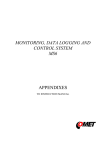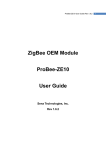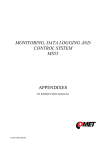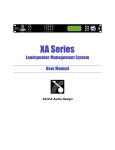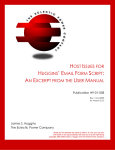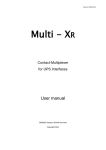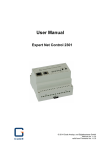Download RAS Manager user manual
Transcript
Version: 2011-10-05 RAS-Manager and RAS-Control Supplementary installation and operation instructions to the CS121 series adapter manual Copyright Statement for Intellectual Property and Confidential Information The information contained in this manual is non-conditional and may be changed without due notice. Although Generex has attempted to provide accurate information within this document, Generex assumes no responsibility for the accuracy of this information. Generex shall not be liable for any indirect, special, consequential, or accidental damage including, without limitations, lost profits or revenues, costs of replacement goods, loss or damage to data arising out of the use of this document Generex the manufacturer of the BACS products undertakes no obligations with this information. The products that are described in this brochure are given on the sole basis of information to its channel partners for them to have a better understanding of the Generex products. Generex allows its channel partners to transfer information contained in this document to third persons, either staff within their own Company or their own customers, either electronically or mechanically, or by photocopies or similar means. Generex states that the content must not be altered or adapted in any way without written permission from Generex. It is agreed that all rights, title and interest in the Generex’s trademarks or trade names (whether or not registered) or goodwill from time to time of Generex or in any intellectual property right including without limitation any copyright, patents relating to the Products, shall remain the exclusive property of Generex. Generex will undertake to deal promptly with any complaints about the content of this document. Comments or complaints about the document should be addressed to Generex Systems GmbH. Copyright of the European Union is effective (Copyright EU). Copyright (c) 1995-2012 GENEREX GmbH, Hamburg, Germany. All rights reserved. Table of contents 1 General information about the RAS Manager 1 2 Installation and configuration 2 2.1 RASMANAGER / CS121PPP configuration for Internet dial up 2.1.1 Common Settings 2 2.1.2 RAS Client Settings 3 2.1.3 RAS Server Settings 4 2.2 RAS-Server Configuration using Windows2000/ XP and 2003 2.2.1 ISDN Access 6 2.2.2 Analog access 7 2.3 Connecting to the RASManager 8 2.4 RAS Control setup 9 2.4.1 gRAS Option for automatically relaying Alarms 9 2.4.2 Alarm relaying per Modem or LAN 10 2.4.3 Phonebook 11 2.4.4 gRAS monitoring 11 3 Functions and Usage 13 3.1 Operating modes of the RAS Manager 13 3.1.1 Client mode 13 3.1.2 Server mode 13 3.1.3 Callback mode 14 3.2 Functions of the RAS Control Software group 14 3.2.1 Phonebook 14 3.2.2 gRAS 14 3.2.3 RAS Control 15 Appendix (sample setup picture sequences) 24 A Dial up 9 steps 25 B Incoming 8 steps 31 C RASPhone 6 steps 35 2 5 1 General information about the RAS Manager Figure 1 RAS-Manager The RAS-Manager relays alarm signals coming from monitoring devices such as UPS, SiteManagers, contact alarms and the like to monitoring stations or email receivers. Any computer with RAS capabilities (Windows, Linux) can be used as a monitoring station. The only requirement is the setup of an PPP-Server on the monitoring station. After the establishment of communications between the RASManager and the monitoring station, a RCCMD signal is sent that depending on configuration can either make log entries, send emails and SMSs or execute programs. Further a remote user can initiate a PPP-RAS connection from the monitoring station to the RAS-Manager. Since the RAS connection functions like a local network, all of the common tools are available for usage (UPSMON, Internet Explorer, Telnet, FTP). This makes a remote configuration of the RAS-Manager possible. As an alternative to this so called server mode, the RAS-Manager can also operate in Callback mode. This option is of considerable importance for customers with special security measures. In this mode, all incoming calls are not accepted, but the incoming call does signal the RAS-Manager to act as a PPP-client and causes the RAS-Manager establish a connection to the preconfigured number in the PPP-client settings. After the establishment of communications, the operater of the monitoring station can select to start either UPSMON, IE, or Telnet in order to continue working with the RAS-Manager. For this purpose, a conventient tool, RAS-Control, is available for Windows monitoring stations. This tool consists of an easy to use phone book, a configuration page containing connection information: connection description, UPS type, callback, etc. and the possiblility to relay alarms via email or SMS. Being a CS121 adapter, most of the RAS-Manager functions are described in the CS121 user manual. The additional functions will be described in this supplement to the user manual. 2 Installation and configuration This section covers the installation and configuration of the RAS Manager and RAS Control program group. Also the setup of the Windows RAS-Services will be covered. Figure 2 RAS Manager configuration page Figure 3 RAS Control Program group 2.1 RASMANAGER / CS121PPP configuration for Internet dial up Make sure that COM2 is set for RAS. Figure 4 RAS Manager COM2 configuration The RAS Configuration http-page consists of three parts: “Common Settings”, “RAS Client Settings” and the “RAS Server Settings”. See Figure 2 RAS Manager configuration page. 2.1.1 Common Settings RAS Configuration: Common Settings In this section the license which came with the RAS Manager or with the seperate purchase of the RAS Control software is entered. Both the „Modem Init String“ and the „Modem First Time Init“ entries are automatically filled in with the correct entries corresponding to the selection made in the „Modem“ Drop down menu. The RAS Manager Phone Number is just a place to store the telephone number of the RAS Manager. 2.1.2 RAS Client Settings Inorder to send emails directly into the internet, the IP address of the SMTP-Servers must be entered into the email configuration settings. The IP address can be determined using a computer that is connected to the internet by pinging the mail server of the mail server. For example: „Ping smtp.1und1.com“ will result in the IP address of the 1&1 - SMTP-Server. Here are a few commonly used SMTP- servers: 1und1 212.227.15.161 t-online 194.25.134.97 web.de 217.72.192.157 The Destination Address is entered into the CS121-PPP-Client settings, that way when emails are to be sent a dial-up connection will be made using the Modem/ ISDN-Adapter. RAS Configuration: RAS Client Settings Exampl: Arcor The Modem-Init-Strings depend on the modem and are therefore not part of these examples. The next step involves entering the telephone number, username and password that are to be used for the connection. The following table provides example entries: Provider Arcor Freenet T-Online Telephone number 0192077 01929 0191011 User name Arcor Freenet User specific Password Internet Freenet The next step involves setting up the email client. This requires using an existing email account with user name and password. The following account can be use for testing purposes: Account: [email protected] user: generex Pass word: cs121snmp IP-Address: 217.72.192.157 It is important that the Server-Address is correct and this IP must also correspond to the address used in the PPP-Client-Settings. After completion of all entries for PPP and E-Mail the RAS Manager must enact a save and reboot. After restarting, the „Test E-Mail Settings“ function, can be used to test the functioning of the dial up connection. 2.1.3 RAS Server Settings RAS Configuration: RAS Server Settings The first check box determines whether the RAS Manager will accept or even register incoming calls. If only the „Act as Server“ box is checked, then the RAS Manager will answer incoming calls and make its services available to the caller if the caller is also in possesion of „Server IP Address“, „Username“, and „Password“. If the second „Enable Callback“ box is also checked, the RAS Manager will not answer incoming calls. Instead, the RAS Manager will register the incoming call as a signal to enact a Dial-up connection to the computer specified in the „RAS Client Settings“. 2.2 RAS-Server Configuration using Windows2000/ XP and 2003 In general it should be noted that the setting up of connections for “dial up”, “incoming” calls and RASPhone book entries differ depending on which version of Windows and which service pack is being used. In addition to the following explanations, in the appendix of this supplement three picture sequences are included as examples of what a typical setup under windows might look like. Configuring and starting the RAS-Server In the Network and Dial-up connections section of the windows control panel, starting (double clicking) the Make new connection icon will start the the windows network connection wizard. Clicking the “Accept incoming connections” stereo button followed by Next begins the setup of the RAS-Services. The assistant then provides the user with a selection of available devices for which one of the options containing “RAS” should be selected in the following the „AVM ISDN RAS“ is selected. Other configuration settings can be made like setting a 10 minute limit for inactivity. Windows Connection Assistant: Devices for Connection properties Incoming Connections In the Users tab of the incoming connection properties, there must be a RAS user entry corresponding to the entry in the RAS client settings. The New… button can be used to add this profile. In the properties window make sure that only TCP/IP is enabled. Make sure that the “Allow callers to access my local area network” box is not checked. Static IP addresses must be assigned in the same fashion as the picture to the left. Finally, the type of password encryption must be specified as PAP. The BatchFile „Papconf.bat“ which is part of the PPPDialer License package handles this process. 2.2.1 ISDN Access If the monitoring station is equipped the an ISDN modem it must also be specified by which incoming MSN calls should be answered. This is either the Telekom MSN (Telephone number without area code) or the extension code of the telephone. These settings are made in the “Phone and Modem options” section of the control panel. On the modem tab select Man CAPI-Port „AVM ISDN RAS“ and select advanced options for incoming and outgoing calls. This is done using the entries: S49=<Number> and S50=<Number>. The entry will look similar to the following: ATS42=1 S49=24 S50=24 (for the extension 24). 2.2.2 Analog access Analoge Modems (ELSA Microlink 56k PCI) require no assignment because this is done by the is done by the phone system. Client connection setup under Windows2000/ XP and 2003 Start the Network connection wizard in the control panel. Select the option: „Dial-up to private network “. Select DFÜ as connection type. Select the appropriate device and give the connection a name. Finally, enter the telephone number under which the RAS Manager can be reached and do not use any smartcard functions. 2.3 Connecting to the RASManager After starting the RAS client connection you will be asked to enter the user name and password. This information should match the entries in the PPP-Server settings. Activate the save name and password check box for future use. Finally, configure the security tab of the connection properties window so that the typical settings allow for the acceptance of “unsafe passwords” in the drop down menu of the securtity options. 2.4 RAS Control setup The Setup of the RAS Control program group is for the greater part fully automated with the requirement of just a few user defined settings. 2.4.1 gRAS Option for automatically relaying Alarms All alarms can be set to be forwarded per default during installation by clicking yes to the following option. If the log file entries and message boxes are sufficient then answer no to this option. This determines how QBLAT will be configured. A yes to this option will activate QBLAT. 2.4.2 Alarm relaying per Modem or LAN Two options are available for the relaying of alarms per email: If LAN is available then select it. Otherwise, if it is necessary to send emails using a dial-up connection then select this option and continue. Next, enter the SMTP Server information. This completes the installation for the LAN option. 2.4.3 Phonebook This section continues the setup for the option Dialup. The Phonebook entry RAS Control group is a special link to the Windows Program PHONEBOOK. The first time this program is started, the file rasphone.pbk is created after which the Windows connection wizard is started for creating a connection and entry for this phonebook. At least one entry must be made in the rasphone.pbk Windows Telephone book inorder for the installation to be completed successfully. The connection will be used later for the relaying of alarms. If no entry is yet available, a new connection can be made using this link at anytime. If the connection already exists simply cancel the next step. 2.4.4 gRAS monitoring The gRAS Service monitores incoming alarms and establishes an internet connection for the forwarding of alarms once an alarm has been detected. For this purpose the Phonebook must be selected when browsing. Afterwards select the appropiate connection and enter the user access data for the selected connection. After completing these steps the service is initiated by clicking the „Save/ Start“ button, and the installation is ended by clicking „Ok“. 3 Functions and Usage In this section, it is assumed that the RASManager and RASControl Software have been successfully installed and configured. Some parts will refer to the adapter user manual. 3.1 Operating modes of the RAS Manager The RASManager can operate in three different modes: Client mode Server mode Callback mode All of these functions are only available after a valid license code has been entered into the adapter. Which of these modes and in which combination they are used is determined by the user. Notice: These functions were designed for static IP–Addresses. 3.1.1 Client mode In Client mode the RAS Manager will call the computer specified by the „Destination Address“ entry. RAS Configuration: RAS Client Settings, Destination Address The RAS Manager will dial-up as Client if: -the RAS Manager receives a call and has been configured for Call back mode in the „RAS Server Settings“. -an Event occurs for which a Job has been defined requiring the relaying of a message or command to an IP address matching that of the „Destination Address“. -the RAS Manager is to send an Email and the IP-Address of the Email-Server in the „Email settings“ matches the IP set in the „Destination Address“ of the RAS client settings. 3.1.2 Server mode When only the „Act as Server“ box is checked in the RAS Server Settings then the RAS Manager will answer incoming calls and make its functions available to the client with the address matching the „Server IP Address“. Other configuration settings may also be necessary to insure this function. These settings are configured in the „Network and Securities Settings“ section of the adapter (see user manual). RAS Configuration: RAS Client Settings, Server IP Address 3.1.3 Callback mode Checking the „Enable Callback“ box will cause the RAS Manager to no longer answer the incoming calls. Instead, once the incoming call ceases, the RAS Manager will dial-up ("Callback") the connection specified in the „RAS Client Settings“. 3.2 Functions of the RAS Control Software group 3.2.1 Phonebook The Phonebook link in the RAS Control Program group is a special link to the Windows-component "Phonebook" that starts the windows connection wizard for the purpose of establishing a valid modem connection entry in the "rasphone.pbk" file. These entries are then made specifically for gRAS and RAS Control. RAS Contol Program group: Phonebook.pbk 3.2.2 gRAS RAS Control Program group: gRAS gRAS is a service that monitors and relays incoming alarms via modem automatically. Once an alarm has been registered, gRAS will initiate a RAS connection and send emails in accordance with specifications made during the installation of gRAS and/or in accordance with specifications made using RAS Control in the „Alarm settings“. This is only relevant for installations using the "Dialup Connection" option (see section 3.2.3, point 7.8) 3.2.3 RAS Control RAS Control unites two different functions into one convenient interface. Establishing connections to RAS Managers, that have been entered into the rasphone.pbk file. This can be done as a result of direct connection or as Callback. Configuration of Alarm receivers. The connections made using RAS Control can be used for different purposes: Starting standard applications Internet Explorer, UPSMON or Telnet that then connect to the predefined IP-Address or for executing user defined programs. If operating in Callback-Modus, the call will signal the computer to call back. Meanwhile, RAS Control will waite until a connection has been established. The callback mode is used in situations requiring higher levels of security. In CallbackModus no options for automating different operations are made available due to security issues, any actions to be take are leftup to the user. Ofcourse, all RAS Control connections can also be disconnected. In this case, all processes started by RAS Control are then terminated as well. By incoming alarms the program "batchgen" is started via RCCMD. Batchgen then either sends the emails specified in the "batch.ini" file by itself in the cas of a LAN setup or generates the necessary batch files that will enact gRAS. If gRAS is activated, it continuously checks for the appearance of such batch files. Upon detection of such a batch-file, gRas establishes RAS connection and executes the instructions contained therein. RAS Control is the configuration interface for "batchgen" which is the key to automating alarm relay process. 3.2.3.1 Using RAS Control RAS Control: main menu After starting RAS Control the main menu appears, making the different RAS Control functions available. 1. "RAS Connection": This drop down menu provides a list for selecting a particular RAS Manager to which a connection is to be established. If available the "Description"-area contains information pertaining to the selected RAS Manager. 2. "Connect/Disconnect": "Connect" will initiate the connection to the selected RAS Manager and "Disconnect" will do the opposite. When no callback mode is configured for the selected connection, either a default application or user defined action will be executed once the connection has been established. Once the connection is ended all of the applications/processes started by RAS Control will also be ended if possible. 3. "Default Application": This stereo box selection determines which application will be started after establishing a connection. During a connection this area can also be used to start the other default applications (InternetExplorer, UPSMON, telnet) as well using "Execute". 4. "View Logfile": Opens the log file under point 6. in the Notepad-Editor. 5. "Status": RAS connection status. 6. "RAS Connections": This opens the RAS connection overview. Overview for "RAS Connections" 6.1 "Add": This adds a new connection entry. Configuration dialoge for RAS Connections 6.1.1 "Name" : This is a drop down menu for selecting the name of an entry made in the RAS Control phone book. The usage of one of the default applications require the entry of an "IP-Address" that match the entry made in the RAS-Manager RAS-Server settings (Default: 192.168.55.1). The execution of user defined processes are to be entered in the “Execute” box. Any entry in the "Execute" field renders the "IPAddress" ineffective and vice versa. 6.1.2 "User" and 6.1.3 "Password" : the correct entries for the corresponding connection must be contained in these fields. 6.1.4 "Description": Anything can be entered into this field for the sake of describing the selected connection. 6.1.5. "Callback: " If the RAS-Manager is in Callback-modus then this check box must be set. 6.1.6 "Callback Timeout": This is the amount of time in seconds that a call should be made in an attempt to triggering the selected RASManager to call back. 30 seconds are recommended for analoge connections and 10 seconds for ISDN with 10 seconds being the minimum. Overview for "RAS Connections" 6.2 "Delete": Deletes the selected entry in the overview table. 6.3 "Edit": Reopens the "Add" configuration window for the purpose of editing the selected entry. 7. "Alarm Settings": Configures “batchgen” and the alarm settings. Clicking the “Alarm settings” button opens the following dialog: Overview for Alarm batch configuration 7.1 "Add" : Adds a new alarm recipient. Configuration for Alarm recipient 7.1.1 "Name": Identifies the the alarm recipient. 7.1.2 "Email-Address": Email-Address of the alarm recipient. 7.1.3."Receive mail": Check box to activate the recipients receiving status. 7.1.4 "Attach logfile": Check box for attaching the Logfile to the recipients email (see 7.5). Overview table for alarm batch configuration 7.2 "Delete": Removes a selected recipient entry. 7.3 "Edit": Opens the selected entry in the add dialog for the sake of editing. 7.4 "Quick Edit": <Space> toggles the recipients status between active=Receiver and inactive=---, and <L> toggles the Logfile attachment between yes and no. 7.5 „Logfile to attach“: This is the name of the logfile to be attached to the email. Default is "log.txt". 7.6 "Logging": When this check box is set all of the incoming alarms are written into a log file. 7.7 "Message": When this check box is set all alarms are accompanied by an alarm signal. 7.8. "Dialup connection": If no LAN connection with internet access is available and the incoming alarms are to be relayed per email then this check box is to be set. This is usually the case when „Dialup Connection“ has been selected during the installation. 8. "Enter licence key": The customer specific license keys are to entered in this section. The standard license provides for 500 entries in the connection list. 4 RASMAN_GSM Standalone Operation Hier fehlt die Beschreibung der Funktion : A. Standalone betrieb – nur SMS : Gerät kann konfiguriert werden das SMS gesendet wird bei Alarm am CS121/BACS und dann auf Anweisungen wartet. Per SMS kann dann Internet GSM Verbindung aktiviert werden und per Webbrowser der CS121/ BACS dann via GSM beobachtet und bedient werden. Vorteil : Damit kann eine preiswerte Prepaid SIM zum Einsatz kommen und eine Flatrate ist nicht notwendig. Nachteil : UNMS kann nur verwendet werden wenn TELESERVICE Option verwendet wird. B. Standlone Betrieb – dauernd online : Gerät kann bei SIM Karte mit Dataflatrate eine dauernde VErbindung im Internet ermögliochen. Dieser Betrieb ist sinnveoll bei UNMS Softwareeinsatz. C. Standlone Betrieb – online on demand : Bei Verwendung der UNMS mit Datacenter Option kann auch SIM mit Prepaid eingesetzt werden, hier wird dann das ein/ausschalten der GSM Internetverbindung durch die UNMS initialisiert. In the following we describe the configuration of the ER75i GSM/EDGE Router. Connect the router via patch cable with your PC (LAN connection at the rear side). Enable the function “Obtain an IP address automatically” into your network settings LAN Connection Local Area Connection Properties Internet Protocol 4 (TCP/Ipv4) Properties. Start a web-browser and enter the IP address 192.168.1.1. Use “root” as user and password to get access. You should change this default password. For security reasons the password should contain digits, numbers and special characters. Advice: It is not required to change something on configuration pages, which are not shown here. At first the IP address of the router will be determined. Get into the menu “LAN Configuration”. Please note, that it is important, that the IP address is different, if you are using several routers. Because the WAN router got the IP address 192.168.1.1, the GSM/EDGE router can start with 192.168.2.1. You should use progressive IP addresses like UPS 1 = 192.168.2.1, UPS 2 = 192.168.3.1 etc. DHCP should be disabled! The GSM/EDGE router possesses a SIM card holder. The details of the APN, user name etc. Will be read directly of the SIM card normally. If not, please contact your provider for the right data. So that the router can be controlled via SMS and will not be establish an internet conection byitself, please set the Default and Backup SIM card to “none”. Select the L2TP connection as VPN connection to the WAN router. Enter the IP address of the remote station (WAN router). So that at a later connection all data can be exchanged, it is required to enter the subnet of the WAN router. This is, even at the usage of several GSM routers, always the 192.168.1.0 with the accordant subnet mask. The required access data for the establishment of the connection have to be defined here too. Quote the address/name of an external timeserver from the internet, for the synchronization of the router and the CS121. You will find a lot of public timeservers. The timezone and the DST can be adjusted too. You can switch off the SNMP server, because it is not required for the monitoring. Now the SMS control have to be enabled. Activate the below mentioned functions and enter the cell phone numbers, which should be allowed for the SMS controlling. In addition the AT-SMS protocol has to be enabled, because for the forwarding of the CS121 alarm messages. Save all settings and restart the router. Attention: After the reboot, the router is available with the configured IP address only. It might be required, that an IP address out of the subnet of the router has to be set. After the reboot of the router, you will receive a SMS with the text “Router has been powered up”. That means, the router is ready. To establish an internet connection, send a SMS with the text “go online sim 1” to the router. After a short time, you will receive a SMS with the text “Router has established PPP connection”. The VPN connection to the WAN router will be established automatically now. To be able to get access via web-browser to the CS121 via VPN tunnel, establish another connection from your PC to the WAN router and enter the IP address of the CS121. The website of the CS121 appears. The buildup of the website depends on the quality of the GPRS connection. If you got all desired data and the internet connection should be closed, send a SMS with the text “go offline”. If required, you can reboot the router via SMS with the text “reboot”. Network settings of the CS121 The network parameter of the CS121 shall be matched with the parameter of the GSM router. If the router was defined for the subnet 192.168.2.0, the CS121 can be defined with the IP address 192.168.2.2 (192.168.2.1 is for the router). You can install up to 254 CS121 behind the subnet of the router. The alarm SMS can be triggered from the CS121 only, which is connected via COM2 to the router. It is required to set the 255.255.255.0 as subnet and the 192.168.2.1 for the gateway (router). In addition you can define the IP address of the router as timeserver for the CS121. The CS121 synchronizes every 24 hours the time and date. Connection to the CS121 Connect within the delivered cable (RJ45 to Mini-Dsub9) from port 1 of the router to the COM2 port of the CS121. In addition connect a network cable from the “ETH” port of the router into the RJ45 socket of the CS121. Therefore the accomodation of your RASMAN_GSM is finished! Appendix (sample setup picture sequences) In the following setup sequences for “dial up” connections, “incoming” calls and RASPhonebook entries some of the pictures are exactly the same and some are slightly different. A Dial up 9 steps 01 - Network Connection Wizard - Welcome.bmp 02 - Network Connection Wizard - Network Connec Type - Dial Up Private.bmp 03 - Network Connection Wizard - Phonenumber.bmp 04- Network Connection Wizard - Select Device.bmp 05 - Network Connection Wizard - Connection Availability.bmp 06 - Network Connection Wizard - Complete.bmp 07 - Network Connection Wizard - Connect Connection.bmp 08 - Network Connection Wizard - Connection Prop.bmp 09 - Network Connection Wizard - Connection Prop Security.bmp B Incoming 8 steps 01 - Network Connection Wizard - Welcome.bmp (same as dial up picture 01) 02 - Network Connection Wizard - Network Connec Type - Accept Incoming Connec.bmp (Same as dial up picture 02 but the “Accept Incoming connections” stereo button is set.) 03 - Network Connection Wizard - Devices For Incoming Connec.bmp 04 - Network Connection Wizard - Incoming Vpn.bmp 05 - Network Connection Wizard - Allowed Users.bmp 06 - Network Connection Wizard - Networking Comp.bmp 07 - Network Connection Wizard - Networking Comp - Incoming Ip Prop.bmp 08 - Network Connection Wizard - Incoming Complete.bmp C RASPhone 6 steps 01 - Rasphone.bmp 02 - Rasphone Network Connection Wizard - Network Connec Type - Dial Up Private.bmp 03 - Network Connection Wizard - Select Device.bmp (same as “dial up” picture 3) 04 - Network Connection Wizard - Phonenumber.bmp 05 - Network Connection Wizard - Connection Availability.bmp 06 - Rasphone Network Connection Wizard - Complete.bmp










































